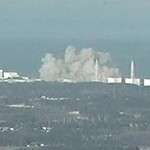The nuclear reactor accident in Japan probably had a substantial amount of radiation released into the environment. We, in medicine, can tell this from the radiation sickness of civilians living and working near the plant.
Radiation sickness is not felt, a person may have no idea that they were exposed, and the early symptoms are typically nausea and vomiting. A small dose of radiation exposure will give the person nausea and vomiting in 2-6 hours after exposure and will resolve in less than a day. Contrast this with the most severe dose of radiation which leads to immediate nausea and vomiting – severe headache and death within 48 hours.
There is a great deal of variation between these – but knowing the onset of symptoms and duration gives a good idea as to how much radiation was at the scene. In the case of the accident in Japan- news reports of patients with symptoms of radiation poisoning and confirmation of exposure to radiation after being hospitalized is an indicator that a substantial amount of radiation was released.
 If these were civilians who were next to the plant, as opposed to workers in the containment area, radiation medicine is specific that the rapidity of symptoms along with a need to be hospitalized means they were exposed to a large dose of radioactive material. The government of Japan has not been forthcoming if these were civilians or workers from the containment area.
If these were civilians who were next to the plant, as opposed to workers in the containment area, radiation medicine is specific that the rapidity of symptoms along with a need to be hospitalized means they were exposed to a large dose of radioactive material. The government of Japan has not been forthcoming if these were civilians or workers from the containment area.
The nuclear accident in Japan begs the question- what happens with radiation poisoning- what can we do to protect ourselves – and should we take iodine?
Radiation sickness from nuclear reactors is in two parts. The initial exposure is from radioactive isotopes can be quite dangerous – it is radioactive iodine. The reason that iodine tablets are prescribed is so the the body will take up the non-radioactive iodine – iodine competes with the radioactive iodine – iodine is naturally taken up by the thyroid. Radioactive iodine decays quickly so the danger in the local area is acute, usually two weeks. The longer lasting radioactive isotopes last about 30 years – which is why the area around Chernobyl is now uninhabitable. This may also be why the area in Japan has been evacuated.
Prevailing winds may carry the radioactive waste westward to the United States, but the weather will also dilute it. While taking iodine is helpful to avoid long-term thyroid damage from potential radioactive iodine, it would be premature to take it at this point. Still- increasing the amount of seafood (which naturally contains high levels of iodine) and using iodized salt instead of Kosher Salt – would not be unwise.
Our hearts go out to the people of Japan at the time of this disaster.
